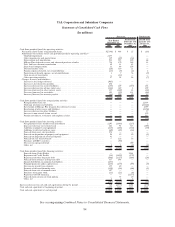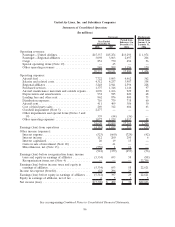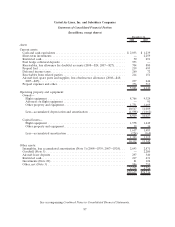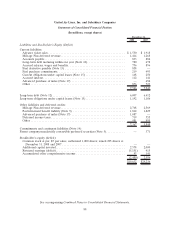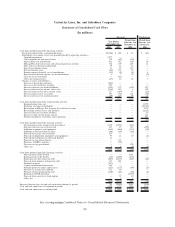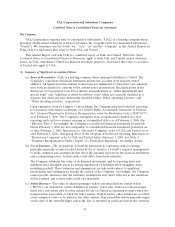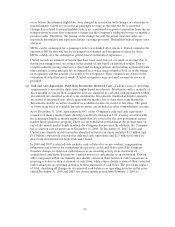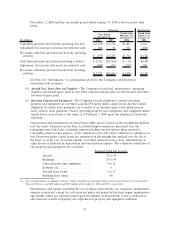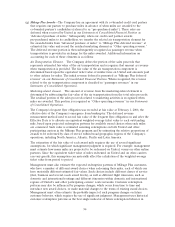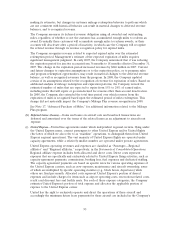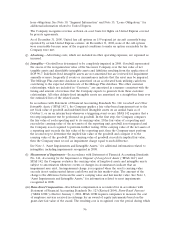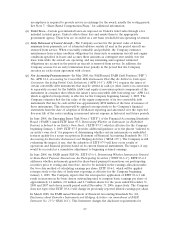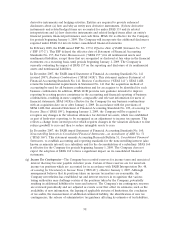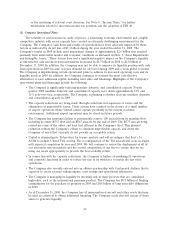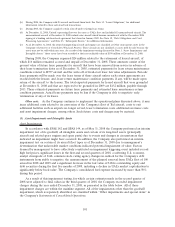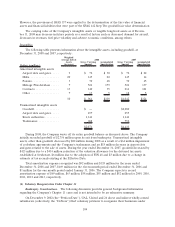United Airlines 2008 Annual Report Download - page 94
Download and view the complete annual report
Please find page 94 of the 2008 United Airlines annual report below. You can navigate through the pages in the report by either clicking on the pages listed below, or by using the keyword search tool below to find specific information within the annual report.(g) Mileage Plus Awards—The Company has an agreement with its co-branded credit card partner
that requires our partner to purchase miles in advance of when miles are awarded to the
co-branded partner’s cardholders (referred to as “pre-purchased miles”). These sales are
deferred when received by United in our Statements of Consolidated Financial Position as
“Advanced purchase of miles.” Subsequently, when our credit card partner awards
pre-purchased miles to its cardholders, we transfer the related air transportation element for
the awarded miles from “Advanced purchase of miles” to “Mileage Plus deferred revenue” at
estimated fair value and record the residual marketing element as “Other operating revenue.”
The deferred revenue portion is then subsequently recognized as passenger revenue when
transportation is provided in exchange for the miles awarded. Additional information on
accounting for each of these elements is as follows:
Air Transportation Element. The Company defers the portion of the sales proceeds that
represents estimated fair value of the air transportation and recognizes that amount as revenue
when transportation is provided. The fair value of the air transportation component is
determined based upon the equivalent ticket value of similar fares on United and amounts paid
to other airlines for miles. The initial revenue deferral is presented as “Mileage Plus deferred
revenue” on our Statements of Consolidated Financial Position. When recognized, the revenue
related to the air transportation component is classified as “passenger revenues” in our
Statements of Consolidated Operations.
Marketing-related element. The amount of revenue from the marketing-related element is
determined by subtracting the fair value of the air transportation from the total sales proceeds.
The residual portion of the sales proceeds related to marketing activities is recognized when
miles are awarded. This portion is recognized as “Other operating revenues” in our Statements
of Consolidated Operations.
The Company’s frequent flyer obligation was recorded at fair value at February 1, 2006, the
effective date of the Company’s emergence from bankruptcy. The deferred revenue
measurement method used to record fair value of the frequent flyer obligation on and after the
Effective Date is to allocate an equivalent weighted-average ticket value to each outstanding
mile, based upon projected redemption patterns for available award choices when such miles
are consumed. Such value is estimated assuming redemptions on both United and other
participating carriers in the Mileage Plus program and by estimating the relative proportions of
awards to be redeemed by class of service within broad geographic regions of the Company’s
operations, including North America, Atlantic, Pacific and Latin America.
The estimation of the fair value of each award mile requires the use of several significant
assumptions, for which significant management judgment is required. For example, management
must estimate how many miles are projected to be redeemed on United, versus on other airline
partners. Since the equivalent ticket value of miles redeemed on United and on other carriers
can vary greatly, this assumption can materially affect the calculation of the weighted-average
ticket value from period to period.
Management must also estimate the expected redemption patterns of Mileage Plus customers,
who have a number of different award choices when redeeming their miles, each of which can
have materially different estimated fair values. Such choices include different classes of service
(first, business and several coach award levels), as well as different flight itineraries, such as
domestic and international routings and different itineraries within domestic and international
regions of United’s and other participating carriers’ route networks. Customer redemption
patterns may also be influenced by program changes, which occur from time to time and
introduce new award choices, or make material changes to the terms of existing award choices.
Management must often estimate the probable impact of such program changes on future
customer behavior, which requires the use of significant judgment. Management uses historical
customer redemption patterns as the best single indicator of future redemption behavior in
94


